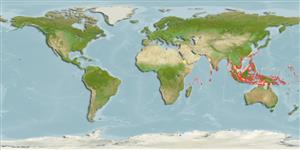>
Eupercaria/misc (Various families in series Eupercaria) >
Gerreidae (Mojarras)
Etymology: Gerres: Latin, gerres = a kind of anchovies; cited by Plinius.
More on author: Bloch.
Environment: milieu / climate zone / depth range / distribution range
Ecologia
marino; salmastro associati a barriera corallina; oceanodromo (Ref. 51243); distribuzione batimetrica 1 - 40 m (Ref. 1602). Tropical; 26°C - 29°C (Ref. 4959); 30°N - 12°S
Indo-West Pacific: Madagascar to Australia. Reported from Vanuatu (Ref. 13300). Larvae reported in Japan as Gerres abbreviatus (Ref. 9902).
Size / Peso / Age
Maturity: Lm ? range ? - ? cm
Max length : 30.0 cm TL maschio/sesso non determinato; (Ref. 12915); common length : 25.0 cm SL maschio/sesso non determinato; (Ref. 37816)
Spine dorsali (totale): 9; Raggi dorsali molli (totale): 10; Spine anali 3; Raggi anali molli: 7. Body silvery with indistinct fine dark stripes along scale rows above and 4-6 rows immediately below lateral line (apparent in newly preserved specimens; larger fishes). Body deep, depth max 1.9-2.3 in SL. Dorsal fin 2nd spine longer than 3rd; anal fin 2nd spine long and robust; caudal fin short and deeply forked; pectoral fins reaches beyond level of anal fin. No scales on upper preopercular flange in approximately 10 cm SL specimens; 1-5 scales (usually 2-3) in over 16 cm SL specimens. Scales between 5th dorsal fin spine base and lateral line 3.5-4.5 (Ref. 28029, 90102). Supraneural bones 3 (Ref. 41102). Ventral and anal fins yellow with white tips Ref. 34765).
Marine species that enters estuaries and coastal lagoons in Madagascar (Ref. 4323). Forms schools on sandy bottoms (Ref. 12915, 48635). Small juveniles feed on zooplankton, larger fish feed on small polychaetes, bivalves, crustaceans and fishes (Ref. 3409). In Palau, spawners migrate from mangroves and sand flats to the outer reef edge around the full moon (Ref. 1602). Marketed fresh or made into fishballs (Ref. 12915).
Life cycle and mating behavior
Maturità | Riproduzione | Deposizione | Uova | Fecundity | Larve
Iwatsuki, Y., S. Kimura and T. Yoshino, 1998. Redescription of Gerres erythrourus (Bloch, 1791), a senior synonym of G. abbreviatus Bleeker, 1850 (Teleostei: Perciformes: Gerreidae). Copeia 1998(1):165-172. (Ref. 28029)
IUCN Red List Status (Ref. 130435)
Threat to humans
Harmless
Human uses
Pesca: scarso interesse commerciale
Informazioni ulteriori
Nomi ComuniSinonimiMetabolismoPredatoriEcotossicologiaRiproduzioneMaturitàDeposizioneSpawning aggregationFecundityUovaEgg development
BibliografiaAcquacolturaProfilo di acquacolturaVarietàGeneticaElectrophoresesEreditarietàMalattieElaborazioneNutrientsMass conversion
CollaboratoriImmaginiStamps, Coins Misc.SuoniCiguateraVelocitàModalità di nuotoArea branchialeOtolithsCervelliVista
Strumenti
Special reports
Download XML
Fonti Internet
Estimates based on models
Preferred temperature (Ref.
123201): 25.2 - 29.1, mean 28.5 °C (based on 694 cells).
Phylogenetic diversity index (Ref.
82804): PD
50 = 0.5000 [Uniqueness, from 0.5 = low to 2.0 = high].
Bayesian length-weight: a=0.01202 (0.00897 - 0.01612), b=3.04 (2.99 - 3.09), in cm total length, based on LWR estimates for this species (Ref.
93245).
Trophic level (Ref.
69278): 3.3 ±0.43 se; based on food items.
Resilienza (Ref.
120179): Alto, tempo minimo di raddoppiamento della popolazione meno di 15 mesi (Preliminary K or Fecundity.).
Fishing Vulnerability (Ref.
59153): Low vulnerability (20 of 100).
Nutrients (Ref.
124155): Calcium = 59.5 [25.4, 105.9] mg/100g; Iron = 0.557 [0.278, 1.092] mg/100g; Protein = 19.1 [17.1, 21.1] %; Omega3 = 0.119 [0.062, 0.210] g/100g; Selenium = 30.7 [15.8, 61.0] μg/100g; VitaminA = 45.3 [10.8, 175.0] μg/100g; Zinc = 1.29 [0.82, 1.91] mg/100g (wet weight);
